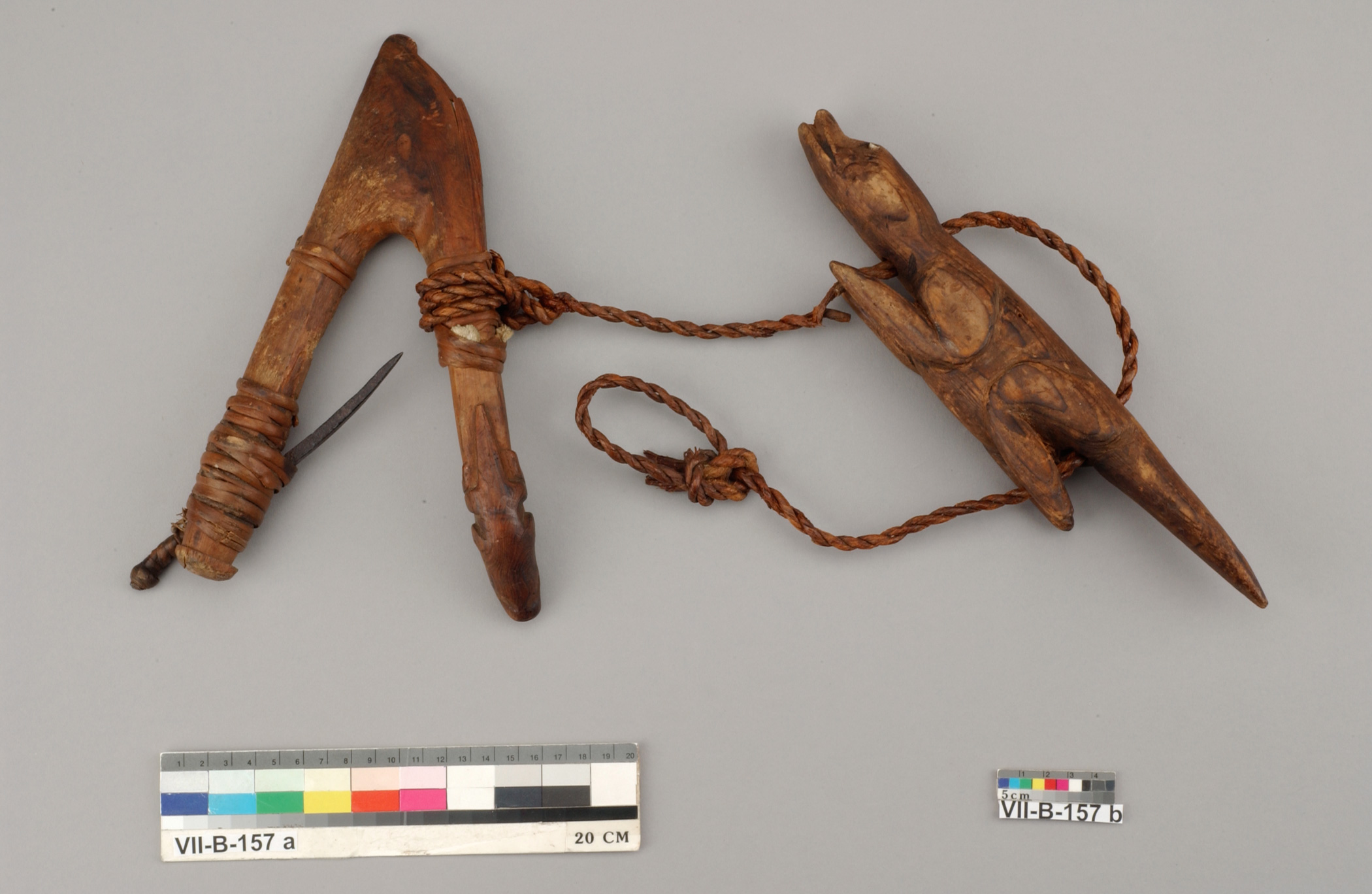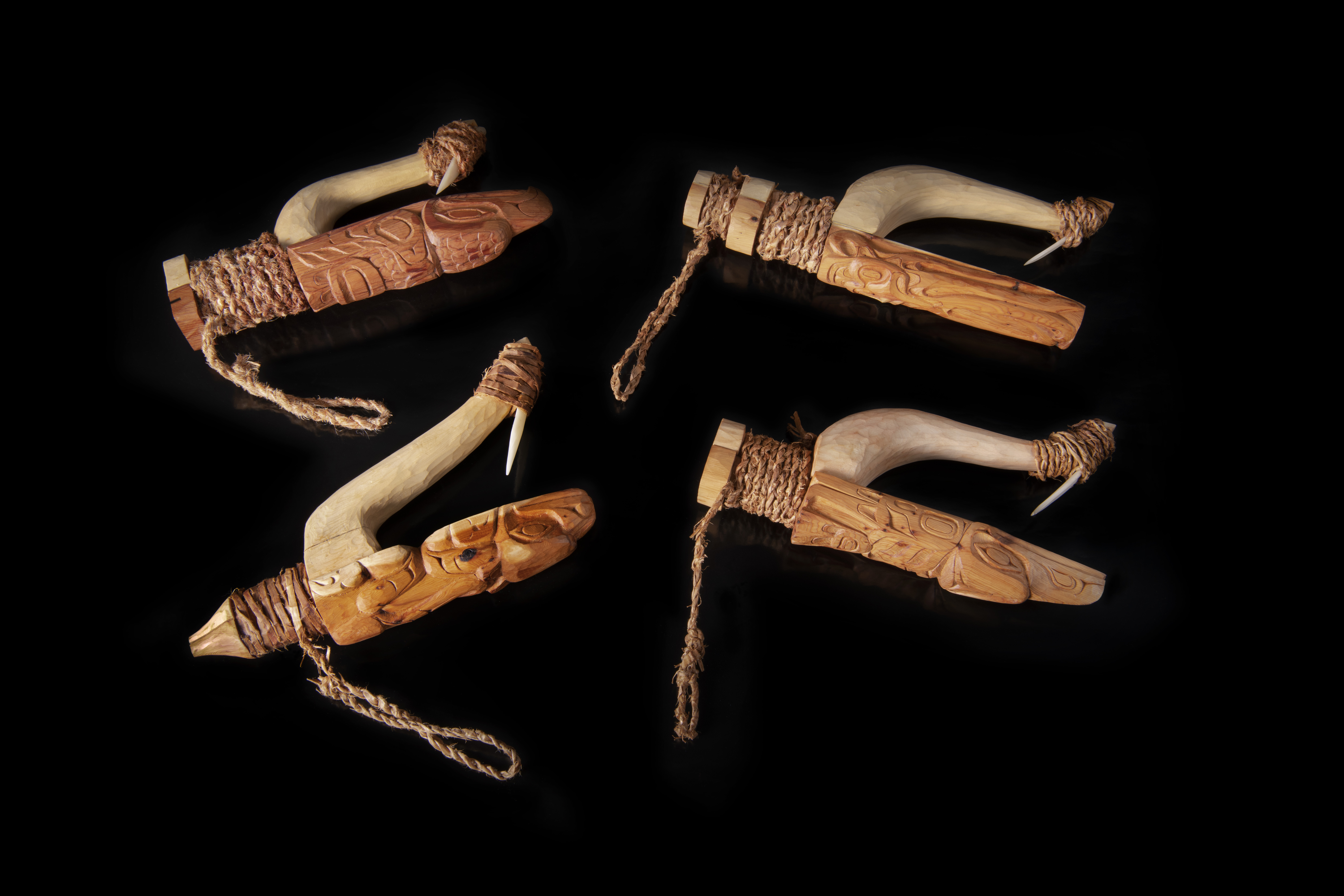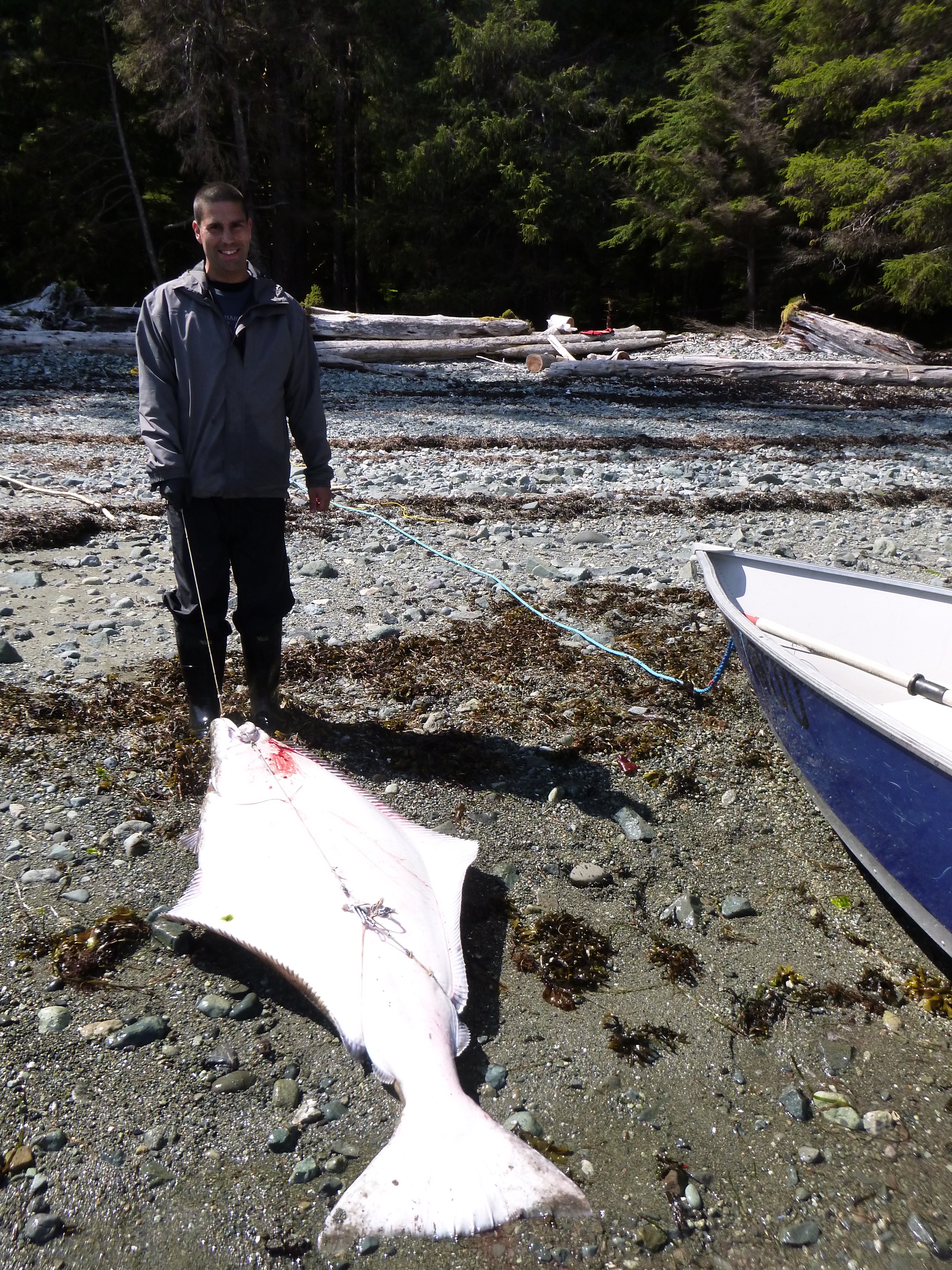Halibut Hook
Artifact
Image
Video
Audio
 Activities
Activities
LOOK
Look closely at this object. What do you think it is used for? Verify your answer by reading the Historical Context below.
LOOK
Look at the different halibut hooks in the media carousel above. What are some similarities between them? What are some differences?
Details
 Materials
Materials - Iron
- Cedar
- Bark
- Spruce Roots
Historical Context
Choose one of the three levels below to match your needs.
- This hook — called xaagu kaydGuu t’aaxul in the Skidegate Haida dialect — was made to catch halibut, a large flatfish species found in the North Pacific Ocean.
- This hook is made from a single piece of cedar. Around the tip of one arm, a long barb of iron is tightly secured with strips of spruce root; on the other arm, the artist has carved the image of an otter holding a fish in its forepaws. A rope, made of twined cedar bark, is tied around this arm, connecting the hook to a large float, which is carved as an otter.
- Halibut still play an important part in the history, culture and foodways (culinary practice and eating habits) of Indigenous peoples of the Northwest Coast.
Scroll through the media carousel above to see pictures of the halibut hooks found in the History Box, information about the various artists who made the hooks, and an image of Sean Young with a halibut fish he caught.
This hook — called xaagu kaydGuu t’aaxul in the Skidegate Haida dialect — was made to catch halibut, a large flatfish species found in the North Pacific Ocean.
Making a halibut hook calls for highly specialized knowledge of materials and design. This hook is made from a single piece of cedar. Around the tip of one arm, a long barb of iron is tightly secured with strips of spruce root; on the other arm, the artist has carved the image of an otter holding a fish in its forepaws. A rope, made of twined cedar bark, is tied around this arm, connecting the hook to a large float, which is carved as an otter. Halibut hooks from the northern Northwest Coast often feature otters; they are respected as powerful beings that can foster success in fishing.
Halibut still play an important part in the history, culture and foodways (culinary practice and eating habits) of Indigenous peoples of the Northwest Coast.
This beautiful halibut hook — called xaagu kaydGuu t’aaxul in the Skidegate Haida dialect — was obtained on Haida Gwaii in the late 19th century, and was made to catch halibut, a large flatfish species found in the North Pacific Ocean. On Haida Gwaii, fishers familiar with the migration routes of halibut can catch the fish almost year-round.
Making a halibut hook calls for a highly specialized knowledge of materials and design. This hook is made from a single piece of cedar. Around the tip of one arm, a long iron barb is tightly secured with strips of spruce root.
On the other arm, the artist has carved the image of an otter holding a fish in its forepaws. A rope made of twined cedar bark is tied around this arm, connecting the hook to a large float, which has been carved as an otter.
The size of this hook suggests that it was made to catch large halibut. From the bite marks along the barbed arm, it looks as though it may have caught several.
Halibut acquire food with a sucking motion. The hook’s design prevents the fish from ingesting the bait. Unable to swallow it, the halibut tries to eject the hook. Instead, this motion secures the barb and the fish is caught.
Take some time to appreciate how this hook is decorated. It has a carved otter on the arm opposite the barb, and an otter as a float. Halibut hooks from the Northwest Coast often feature otters; they are respected as powerful beings that can foster success in fishing. Halibut fishing can be dangerous, and hooks are very personal objects.
Halibut still play an important part in the history, culture and food ways (culinary practice and eating habits) of Indigenous peoples of the Northwest Coast. Find out about the creative and beautiful ways in which artists have honoured the halibut by looking at various historical and contemporary works in the Museum’s collection.
The hooks in this kit were made by several Haida artists (Raven LeBlanc, Captain Stewart-Burton, Allan Wilson and Billy Yovanovich), who live and work on Haida Gwaii, British Columbia.
- This hook — called xaagu kaydGuu t’aaxul in the Skidegate Haida dialect — was made to catch halibut, a large flatfish species found in the North Pacific Ocean.
- This hook is made from a single piece of cedar. Around the tip of one arm, a long barb of iron is tightly secured with strips of spruce root; on the other arm, the artist has carved the image of an otter holding a fish in its forepaws. A rope, made of twined cedar bark, is tied around this arm, connecting the hook to a large float, which is carved as an otter.
- Halibut still play an important part in the history, culture and foodways (culinary practice and eating habits) of Indigenous peoples of the Northwest Coast.
Scroll through the media carousel above to see pictures of the halibut hooks found in the History Box, information about the various artists who made the hooks, and an image of Sean Young with a halibut fish he caught.
This hook — called xaagu kaydGuu t’aaxul in the Skidegate Haida dialect — was made to catch halibut, a large flatfish species found in the North Pacific Ocean.
Making a halibut hook calls for highly specialized knowledge of materials and design. This hook is made from a single piece of cedar. Around the tip of one arm, a long barb of iron is tightly secured with strips of spruce root; on the other arm, the artist has carved the image of an otter holding a fish in its forepaws. A rope, made of twined cedar bark, is tied around this arm, connecting the hook to a large float, which is carved as an otter. Halibut hooks from the northern Northwest Coast often feature otters; they are respected as powerful beings that can foster success in fishing.
Halibut still play an important part in the history, culture and foodways (culinary practice and eating habits) of Indigenous peoples of the Northwest Coast.
This beautiful halibut hook — called xaagu kaydGuu t’aaxul in the Skidegate Haida dialect — was obtained on Haida Gwaii in the late 19th century, and was made to catch halibut, a large flatfish species found in the North Pacific Ocean. On Haida Gwaii, fishers familiar with the migration routes of halibut can catch the fish almost year-round.
Making a halibut hook calls for a highly specialized knowledge of materials and design. This hook is made from a single piece of cedar. Around the tip of one arm, a long iron barb is tightly secured with strips of spruce root.
On the other arm, the artist has carved the image of an otter holding a fish in its forepaws. A rope made of twined cedar bark is tied around this arm, connecting the hook to a large float, which has been carved as an otter.
The size of this hook suggests that it was made to catch large halibut. From the bite marks along the barbed arm, it looks as though it may have caught several.
Halibut acquire food with a sucking motion. The hook’s design prevents the fish from ingesting the bait. Unable to swallow it, the halibut tries to eject the hook. Instead, this motion secures the barb and the fish is caught.
Take some time to appreciate how this hook is decorated. It has a carved otter on the arm opposite the barb, and an otter as a float. Halibut hooks from the Northwest Coast often feature otters; they are respected as powerful beings that can foster success in fishing. Halibut fishing can be dangerous, and hooks are very personal objects.
Halibut still play an important part in the history, culture and food ways (culinary practice and eating habits) of Indigenous peoples of the Northwest Coast. Find out about the creative and beautiful ways in which artists have honoured the halibut by looking at various historical and contemporary works in the Museum’s collection.
The hooks in this kit were made by several Haida artists (Raven LeBlanc, Captain Stewart-Burton, Allan Wilson and Billy Yovanovich), who live and work on Haida Gwaii, British Columbia.
Summary
- This hook — called xaagu kaydGuu t’aaxul in the Skidegate Haida dialect — was made to catch halibut, a large flatfish species found in the North Pacific Ocean.
- This hook is made from a single piece of cedar. Around the tip of one arm, a long barb of iron is tightly secured with strips of spruce root; on the other arm, the artist has carved the image of an otter holding a fish in its forepaws. A rope, made of twined cedar bark, is tied around this arm, connecting the hook to a large float, which is carved as an otter.
- Halibut still play an important part in the history, culture and foodways (culinary practice and eating habits) of Indigenous peoples of the Northwest Coast.
Scroll through the media carousel above to see pictures of the halibut hooks found in the History Box, information about the various artists who made the hooks, and an image of Sean Young with a halibut fish he caught.
Essential
This hook — called xaagu kaydGuu t’aaxul in the Skidegate Haida dialect — was made to catch halibut, a large flatfish species found in the North Pacific Ocean.
Making a halibut hook calls for highly specialized knowledge of materials and design. This hook is made from a single piece of cedar. Around the tip of one arm, a long barb of iron is tightly secured with strips of spruce root; on the other arm, the artist has carved the image of an otter holding a fish in its forepaws. A rope, made of twined cedar bark, is tied around this arm, connecting the hook to a large float, which is carved as an otter. Halibut hooks from the northern Northwest Coast often feature otters; they are respected as powerful beings that can foster success in fishing.
Halibut still play an important part in the history, culture and foodways (culinary practice and eating habits) of Indigenous peoples of the Northwest Coast.
In-Depth
This beautiful halibut hook — called xaagu kaydGuu t’aaxul in the Skidegate Haida dialect — was obtained on Haida Gwaii in the late 19th century, and was made to catch halibut, a large flatfish species found in the North Pacific Ocean. On Haida Gwaii, fishers familiar with the migration routes of halibut can catch the fish almost year-round.
Making a halibut hook calls for a highly specialized knowledge of materials and design. This hook is made from a single piece of cedar. Around the tip of one arm, a long iron barb is tightly secured with strips of spruce root.
On the other arm, the artist has carved the image of an otter holding a fish in its forepaws. A rope made of twined cedar bark is tied around this arm, connecting the hook to a large float, which has been carved as an otter.
The size of this hook suggests that it was made to catch large halibut. From the bite marks along the barbed arm, it looks as though it may have caught several.
Halibut acquire food with a sucking motion. The hook’s design prevents the fish from ingesting the bait. Unable to swallow it, the halibut tries to eject the hook. Instead, this motion secures the barb and the fish is caught.
Take some time to appreciate how this hook is decorated. It has a carved otter on the arm opposite the barb, and an otter as a float. Halibut hooks from the Northwest Coast often feature otters; they are respected as powerful beings that can foster success in fishing. Halibut fishing can be dangerous, and hooks are very personal objects.
Halibut still play an important part in the history, culture and food ways (culinary practice and eating habits) of Indigenous peoples of the Northwest Coast. Find out about the creative and beautiful ways in which artists have honoured the halibut by looking at various historical and contemporary works in the Museum’s collection.
The hooks in this kit were made by several Haida artists (Raven LeBlanc, Captain Stewart-Burton, Allan Wilson and Billy Yovanovich), who live and work on Haida Gwaii, British Columbia.



